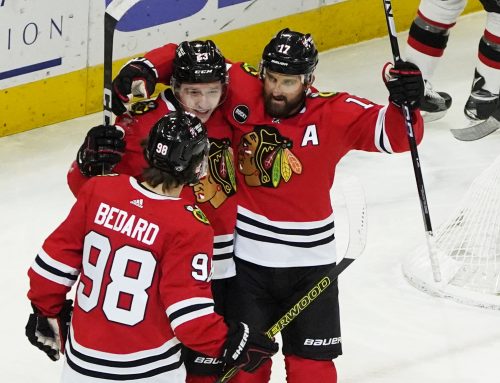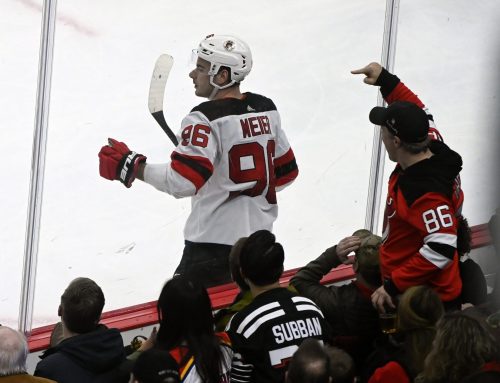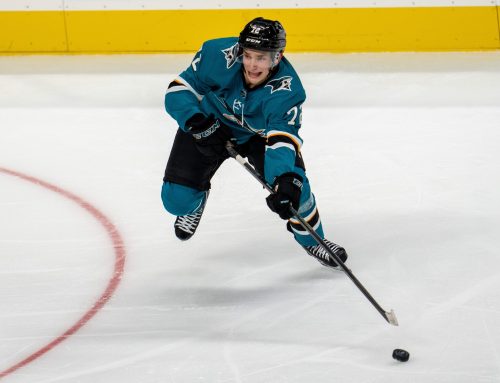Ramblings: Bounce Back Candidates (May 20)
Cam Robinson
2020-05-20
Regular update that gives absolutely no indication of when the draft will occur or what the NHL playoffs may look like this summer:
NHL deputy commissioner Bill Daly says he’s hopeful today’s Canada-U.S. border announcement “will not materially affect the resumption of play timelines we are currently contemplating.”
— Chris Johnston (@reporterchris) May 19, 2020
I’m going to go ahead and assume that non-essential travel will indeed include athletes. But then again, we’re talking about a billion-dollar industry that holds a decent amount of sway in government circles, so who knows.
**
If you haven’t already, go ahead and read this
“The purpose of this story is not to drag everyone in hockey, or the sport itself, into the mud. This is about the biggest problems facing the game I love — and how we can fix them.”@Dreamer_Aliu78 calls out racist abuse in the hockey community.https://t.co/KTL7ERds3O
— The Players’ Tribune (@PlayersTribune) May 19, 2020
**
Over at DobberProspects, we’ve begun to release our Fantasy Organizational Rankings series. This piece always delivers a plethora of goodies for those in deep keeps and dynasty leagues. This year, our Special Content Manager, Peter Harling has been tabulating the results from myself, our Director of European Scouting, Jokke Nevalainen, our Director of North American Scouting, Tony Ferrari, and our remaining Associate Editors.
The proof, as they say, is in the pudding.
2020-21 DobberProspects Organizational Rankings: 31-26 https://t.co/P8KCaw94h3 pic.twitter.com/lttEKDtPBc
— DobberProspects (@DobberProspects) May 18, 2020
**
Mikkel Boedker signs a two-year deal with HC Lugano. In announcing the new contract, the Swiss team says it “will wait for” Boedker in the unlikely event that Ottawa Senators are required to play more games in 2019-20. https://t.co/bsAaD9gfn5
— Chris Johnston (@reporterchris) May 19, 2020
This is super interesting. Boedker, who was dealt for Mike Hoffman less than two years ago, is now out of the league. Hoffman, by the way, was on pace for a 35-35-70 season with the Panthers. But it’s pretty wild that Lugano signed him now, knowing he could play more games with the Sens. Almost as wild as Boedker signing knowing he could play more games with the Sens.
How’s that going to work in the room?
At the end of the day, there are zero reasons for the Senators to play any more games this year, so it’s likely just a wave good-bye to the former eighth overall selection.
**
One of the most difficult aspects of fantasy hockey is accurately identifying assets and where they are in their production cycle. When to cut bait on a long-time star before the bottom falls out. When to buy-low on a player who disappointed but should have more left in the tank.
Early this week, Dobber did a terrific job of outlining 17 potential bounce back options. Today, I’ll delve a little deeper into those players who stumbled in 2019-20 but could still provide increased value in 2020-21 and beyond.
Strong Bets
This one was a pretty big surprise to me. Arvidsson was one of the very few players to see a statistical improvement year over year through his first four full NHL campaigns. That included a continual boost in the shots-per-game column. His 2018-19 season was cut to just 58 contests, but he was clicking at a pretty ridiculous 48-goal pace while hitting on 17 percent of his shots.
The Preds as a club were pretty much the same offensive team this season. They’re a bottom-of-the-league power-play squad – actually jumping from 31st to 25th this past season. They consistently put 32-plus shots on goal per game. But Arvidsson was driving a ton of their even-strength offense until this past year.
The main reasons to expect him to rebound are as follows:
• There’s no reason to believe a player who consistently put three-plus shots on goal per game will now be a two-shot-per-game guy. So let’s be conservative and say he’s good for 240 shots over a full year.
• The conversion rate is safely established in the low double-digits. Again, conservatively, call it 11 percent. We’re talking about a minimum of 26 goals.
• He was down nearly three minutes per game – almost exclusively at even-strength. Again, that cannot be a thing for a player in the prime of his career. Those minutes are coming back up.
Finally, it could have not been easy coming back from this injury:
Viktor Arvidsson injured after taking two nasty cross-checks from Robert Bortuzzo pic.twitter.com/v8jVySeoab
— Brady Trettenero (@BradyTrett) November 24, 2019
Give me at least a 30-30-60 season if he can stay healthy in 2020-21. But that in itself is another question altogether.
While Arvidsson was continually improving his metrics with each passing season, Klingberg was bouncing around with more inconsistency. That was highlighted perfectly by his 2019-20 season. He began the year with a putrid four points in 17 games. He was seeing the fun ice but just couldn’t do anything with it.
He wasn’t the only Star to be struggling, but he was indeed struggling.
The next 17 games saw him flip the script and post 14 points. It was the same deployment as before, just now the points were flowing. In totality, the back 41 games represented a pretty solid 56-point pace and in line with his ‘usual’ level of production. It was also a terrific sign of where he should hopefully be heading next season.
The key here is whether you’re concerned with Miro Heiskanen stealing the top power-play deployment from the 27-year-old Swede. It’s a valid concern. Heiskanen just saw the highest PPTOI of his career with 2:14 this season. Meanwhile, Klingberg saw the lowest of his career at 2:33.
I’m betting that the Stars utilize their players to their highest potential, and that means giving Klingberg a lot of offensive deployment. They’ll need the forwards to wake up, but both players should be locks for 40 points, but I’m taking the over on Klingberg at 49.5.
Here’s a riddle for you, does the Flames’ PP production push Gaudreau’s numbers or do Gaudreau’s numbers push the Flames’ PP? I lean on the latter by the eye test, but the metrics don’t agree.
Over the past five seasons, the 26-year-old has produced pacing totals of 81, 69, 86, 99, and then this season, 68. The two outlier sub-point-per-game years coincidently occurred while the star winger failed to hit high PPP marks.
When Gaudreau produced that career-best 99 points and 27 PPPs in 2018-19, Calgary posted the 18th best power-play numbers. This past season, where Gaudreau had a near-career low of 18 PPPs, the Flames were 12th. So what gives? Well, in this instance, what gives was the power-play numbers went down a hair, but the even-strength production took a substantial hit.
Despite the shot rates staying steady, Gaudreau watched his 5v5 shooting percentage fall three points this past season. His personal shooting rate in all situations dipped over six points. That isn’t something we expect to see happen year over year. Especially for a star player in his prime.
The Flames PP appears to be steady and on track to maintain it’s holding as a top-half of the league club. And if we’re taking bets on a player regaining his form in all-situations, there may not be any better options than Gaudreau.
A Little Less Sure
The Tyson Barrie experiment will come to an end this summer. It didn’t work, and frankly, it didn’t make a whole lot of sense to begin with. I get it, Nazem Kadri was making too much money to be a third-line centre. But Barrie was always going to be less effective as a secondary option (another reason the Stars shouldn’t dunk Klingberg down the pecking order)
But the addition of Barrie wasn’t the only reason that the Leafs’ number one defender saw his impact reduced considerably.
The 26-year-old was coming off a career-high 72 points on the back of an unsustainable nine percent conversion rate and a career-best 51 even-strength points. Hell, up until that point, his high water mark was 52 TOTAL points.
But 2019-20 saw that conversion rate crater back down to just two percent. His offensive zone starts dipped a little as Barrie came aboard. His IPP flopped way down by 12 points, and his season pretty well wrapped early with a foot injury. His most productive stretch came in the first quarter of the season when he was seeing over three minutes of power-play time per night and produced 17 points in just 21 games.
However, that was with Mike Babcock running the show. When Sheldon Keefe came aboard as of November 20th, Rielly averaged just 37.5 percent of the power-play ice in his 20 healthy contests. Not exactly an inspiring situation moving forward.
While I don’t think we should expect Rielly to mimic that career-year of 2018-19, the 47 point-pace from this past season – with all its streakiness, isn’t sustainable either. A nice healthy return to the 55-plus zone seems in the cards… assuming the Leafs don’t go out and try another defender on PP1.
Seguin remains an elite talent. That didn’t go away in his age-28 campaign. What did go away was the volume-shooting, low-teens converting, power-play dominant scorer that we’ve become accustomed too.
Seguin saw nearly all of his metrics take a serious hit this past season. The conversion rate has been slowly dropping the last few seasons, but I don’t know anyone who thinks Seguin is a six percent finisher. The Stars aren’t adding any new offensive firepower for next season, so they’ll have to hope the gains from Roope Hintz and Denis Gurianov can help ease the slides of Jamie Benn and Alex Radulov.
At the end of the day, it’ll be up to Seguin to find his mojo and push back to being an 80-point threat. He’s got the skill to do it, but it’s not a lock at this point.
**
Follow me on Twitter @Hockey_Robinson





 WSH
WSH NYR
NYR NSH
NSH VAN
VAN COL
COL WPG
WPG L.A
L.A EDM
EDM CHI
CHI T.B
T.B CAR
CAR NYI
NYI SEA
SEA
